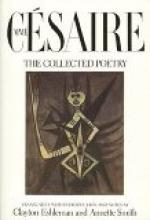|
This section contains 5,415 words (approx. 19 pages at 300 words per page) |

|
SOURCE: Wolitz, Seth L. “The Hero of Negritude in the Theater of Aimé Césaire.” Kentucky Romance Quarterly 16, no. 3 (1969): 195-208.
In the following essay, Wolitz examines the didactic function of the hero in Césaire's plays.
“J'ai marché devant tous, triste et seul dans ma gloire.”
—Alfred de Vigny
The poet-president Léopold Senghor has written many theoretic tracts on Negritude,1 but Aimé Césaire, poet, playwright, Mayor of Fort-de-France, has expounded, for the most part, his vision of Negritude in verse and drama.
… ma Négritude n'est ni une tour ni une cathédrale .....elle plonge dans la chair rouge du sol elle plonge dans la chair ardente du ciel …
(Cahier, p. 71)2
Césaire, like Lorca, began with poetry and turned to theater later in his career. The stage offered a larger audience and a more dynamic expression.
Art, for Césaire, provided the rhetorical vehicle for...
|
This section contains 5,415 words (approx. 19 pages at 300 words per page) |

|


